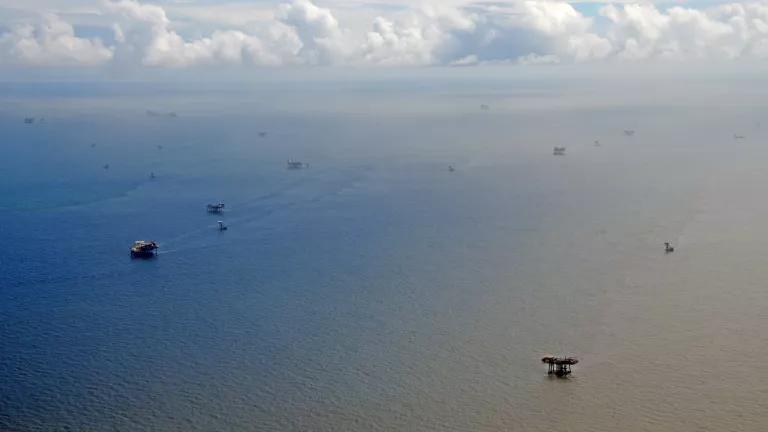Trump Budget Slashes Coastal and Ocean Funding
The Trump Administration’s 2018 federal budget proposal doubles down on attempts to weaken our nation’s ocean and coastal arm, the National Oceanic and Atmospheric Administration (NOAA), with a dramatic cut of 16 percent from the enacted 2017 omnibus budget. Several NOAA divisions are recommended for slashing and important coastal and ocean management, research, and education programs would be eliminated entirely if Congress went along with this proposal.
Today’s budget proposes deep cuts to NOAA’s:
- Satellite program which tracks hurricanes, tornadoes, and severe storms, and supports aviation and ocean navigation decisions, keeping airline passengers, fishermen, shippers and boaters safe.
- Office of Oceanic and Atmospheric Research that provides America with better forecasts and earlier warnings for natural disasters.
- National Ocean Service, which helps ensure safe maritime navigation; assists communities struggling with the real and immediate impacts of climate change, like sea level rise and coastal flooding; and conserves marine wildlife and habitats for all of us to enjoy.
The budget would completely eliminate NOAA programs that are critical to the 124 million people who call our oceans and Great Lakes coasts home, including:
- The Coastal Zone Management Grants Program, which funds 34 states and territories to protect coastal water quality, ensure coastal habitats are able to buffer homes and businesses from storms, sustain healthy fish and wildlife populations, and keep beaches open for tourists and residents to enjoy. State coastal zone managers ensure proposed offshore industrial activities, like energy development proposals, are consistent with the state’s federally approved coastal policies.
- Regional Coastal Resilience Grants, which fund states and local governments to address regional challenges that, by nature, cross state lines, like ocean acidification and marine debris.
- The National Estuarine Research Reserve System, designed to protect and study some of the most biologically-productive places on the planet from the Hudson River to San Francisco Bay.
- The Sea Grant Program, which funds coastal researchers at hundreds of universities nationwide to work with local businesses and stakeholders to develop solutions for on-the-ground challenges, like reducing the Great Lakes’ nutrient pollution and improving methods for Gulf of Mexico oyster aquaculture.
- Arctic research focused on sea ice modeling and predictions, and modeling of ecosystem and fisheries vulnerabilities to changing ocean conditions.
- John H. Prescott Marine Mammal Rescue Assistance Grants, which fund rescue and rehabilitation of endangered whales and other marine life that can get caught in fishing gear and strand on beaches. The budget also eliminates the Marine Mammal Commission, an independent agency that for more than 40 years has helped lead marine mammal conservation off our coasts.
White House Budget Director Mick Mulvaney stated, “People don’t mind paying their taxes as long as they know their money is not being wasted.” Similarly, the White House budget notes: “The Budget proposes to eliminate funding for several lower priority … grant and education programs.”
But healthy oceans and coasts aren’t lower priority or wasteful spending for all who live, work, and visit America’s oceans and Great Lakes. NOAA programs are the front line for families struggling with the real and immediate impacts of climate change, like sea level rise and coastal flooding. And cutbacks to NOAA’s satellite data division will shortchange scientists developing climate forecasts that help all of us understand how what we’re seeing today compares to climate trends in the past.
It’s hard to say how exactly states will be able to plug the holes if these massive cuts come to fruition. For example, the Department of Commerce’s budget summary states that “NOAA will continue to support states’ participation in the National [Coastal Zone Management] program by reviewing and supporting implementation of states’ management plans, supporting Federal consistency reviews, and providing technical assistance services,” but the fact is that without Coastal Zone Management Program Grants, Virginia could lose their coastal zone managers altogether and New York might see a reduction of up to half of their coastal staff. California’s Coastal Commission receives 10 percent of its budget through coastal zone management grants to the state—staff would be laid off and additional cuts would likely be needed to fill the funding gap.
Our oceans and Great Lakes contribute hundreds of billions of dollars in goods and services to the country’s gross domestic product and employ millions of people. And use of these resources is growing rapidly—from both traditional uses like shipping, fishing, and recreation, and new industries like aquaculture and offshore renewable energy. With fewer coastal zone managers to review offshore development proposals, we could see delays in permitting and possibly less than optimal oversight of our public coastal and ocean resources.
Too many people rely on healthy oceans and coasts for Congress to turn its back on funding these programs. NRDC expects Congressional leaders to reject these unnecessary and counterproductive cuts.




